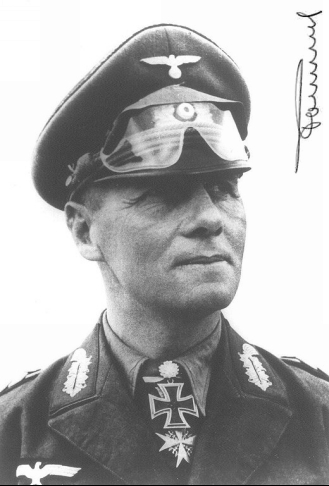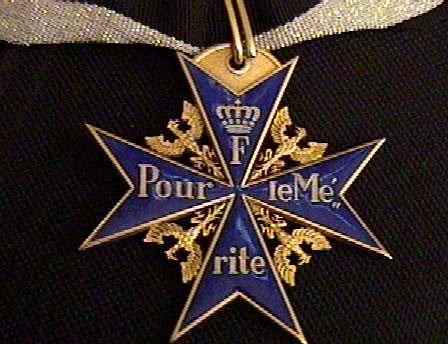Feldmarshall Erwin Rommel
(15 November 1891 – 14 October 1944), popularly known as the Desert Fox.
He was a highly decorated officer in World War I, and was awarded the Pour le Mérite for his exploits on the Italian front. In World War II, he further distinguished himself as the commander of the 7th Panzer Division during the 1940 invasion of France. However, it was his leadership of German and Italian forces in the North African campaign that established the legend of the Desert Fox. He is considered to have been one of the most skilled commanders of desert warfare in the war. He later commanded the German forces opposing the Allied cross-channel invasion in Normandy.
As one of the few generals who consistently fought the Western Allies (he was never assigned to the Eastern Front), Rommel is regarded as having been a humane and professional officer. His Afrikakorps was never accused of war crimes. Soldiers captured during his Africa campaign were reported to have been treated humanely. Furthermore, he ignored orders to kill captured commandos, Jewish soldiers and civilians in all theaters of his command.
Late in the war, Rommel was linked to the conspiracy to kill Adolf Hitler. Due to his wide renown, Hitler chose to eliminate him quietly; in trade for the protection of his family, Rommel agreed to commit suicide.
Rommel was born on 15 November 1891 in Heidenheim, 45 kilometres (28 mi) from Ulm, in the Kingdom of Württemberg (then part of the German Empire). He was baptised on 17 November 1891. He was the second child of the Protestant headmaster of the secondary school at Aalen, Professor Erwin Rommel Senior (1860–1913), and Helene von Luz, who had two other sons and a daughter. Rommel wrote that "my early years passed quite happily."

At age 14, Rommel and a friend built a full-scale glider that was able to fly short distances. Rommel even considered becoming an engineer and throughout his life displayed extraordinary technical aptitude. Acceding to his father's wishes, Rommel instead joined the local 124th Württemberg Infantry Regiment as an officer cadet in 1910 and was sent to the Officer Cadet School in Danzig. He graduated on 15 November 1911 and was commissioned as a lieutenant in January 1912.
While at Cadet School, Rommel met his future wife, 17-year-old Lucia Maria Mollin (commonly called Lucie). They married on 27 November 1916 in Danzig and on 24 December 1928 had a son, Manfred Rommel, who later became the Mayor of Stuttgart. Some historians believe Rommel also had a relationship with Walburga Stemmer in 1913, which allegedly produced a daughter, Gertrud.
During World War I, Rommel fought in France as well as in Romania (see: Romanian Campaign) and Italy (see: Italian Campaign), first in the 6th Württemberg Infantry Regiment, but through most of the war in the Württemberg Mountain Battalion of the elite Alpenkorps. He gained a reputation for great courage, making quick tactical decisions and taking advantage of enemy confusion. He was wounded three times and awarded the Iron Cross, First and Second Class. Rommel also received Prussia's highest award, the order of Pour le Mérite, after fighting in the Battles of the Isonzo in the mountains west of Slovenia on the Soča front. The award was for the Battle of Longarone and the capture of Mount Matajur and its Italian defenders, which totalled 150 officers, 9,000 men, and 81 artillery pieces. For a time, he served in the same infantry regiment as Friedrich Paulus. While fighting at Isonzo, Rommel was caught behind Italian lines but managed to escape capture, though almost all of his staff were taken prisoner. In the Second World War, when the Germans and Italians were allies, Rommel tempered his initial disdain of Italian soldiers, when he realized that their lack of success was principally due to poor leadership and equipment. When these difficulties were overcome they were equal to German forces. Erwin Rommel wrote a book, Infantry Attacks, in which he examined and analyzed the many battles he fought in during World War I. It was published in 1937 and became essential reading for both German and allied commanders during World War II. He taught his men to dig in whenever they paused for any length of time. This paid off many times when French artillery fired upon his position, only to be shrugged off by the entrenchments built by Rommel's men.

Rommel turned down a post in the Truppenamt (the camouflaged General Staff), whose existence was forbidden by the Treaty of Versailles—the normal path for advancing to high rank in the German army. Instead, he preferred to remain a frontline officer.
Rommel held battalion commands and was an instructor at the Dresden Infantry School from 1929 to 1933. In 1934, his book for infantry training, “Gefechts-Aufgaben für Zug und Kompanie : Ein Handbuch für den Offizierunterricht“ (Combat tasks for platoon and company: A manual for the officer instruction), appeared. This book was printed until 1945 in five editions, with revisions and changes of title. From 1935 to 1938, Rommel held commands at the Potsdam War Academy. Rommel's war diaries, Infanterie greift an (Infantry Attacks), published in 1937, became a highly regarded military textbook and attracted the attention of Adolf Hitler, who placed Rommel in charge of the War Ministry liaison with the Hitler Youth's (Hitler Jugend), Headquarters of Military Sports, the branch involved with paramilitary activities, primarily terrain exercises and marksmanship. Rommel applied himself energetically to the task. The army provided instructors to the Hitler Youth Rifle School in Thuringia, which in turn supplied qualified instructors to the HJ's regional branches.
In 1937, Rommel conducted a tour of Hitler Youth meetings and encampments and delivered lectures on German soldiering while inspecting facilities and exercises. Simultaneously, he was pressuring Baldur von Schirach, the Hitler Youth leader, to accept an agreement expanding the army's involvement in Hitler Youth training. Schirach interpreted this as a bid to turn the Hitler Youth into an army auxiliary, a "junior army" in his words. He refused and denied Rommel (whom he had come to dislike personally, apparently out of envy for his "real soldier's" appeal) access to the Hitler Youth. An agreement was concluded, but on a far more limited scope than Rommel sought; cooperation was restricted to the army's providing personnel to the rifle school. By 1939 the Hitler Youth had 20,000 rifle instructors. Simultaneously, Rommel retained his place at Potsdam. Rommel was awarded the highest war ribbons for excellent performance.
In 1938 Rommel, now a colonel, was appointed Kommandant (commander) of the War Academy at Wiener Neustadt (Theresian Military Academy). Rommel was removed after a short time, however, to take command of Adolf Hitler's personal protection battalion (FührerBegleitbataillon), assigned to protect him in the special railway train (Führersonderzug) used during his visits to occupied Czechoslovakia and Memel. It was during this period that he met and befriended Joseph Goebbels, the Reich's minister of propaganda. Goebbels became a fervent admirer of Rommel and later ensured that Rommel's exploits were celebrated in the media.
Poland 1939Rommel acted as commander of the Führerbegleithauptquartier (Führer escort headquarters) during the Poland campaign, often moving up close to the front in the Führersonderzug and seeing much of Hitler. After the Polish defeat, Rommel returned to Berlin to organize the Führer's victory parade, taking part himself as a member of Hitler's entourage. During the Polish campaign, Rommel was asked to intervene on behalf of one of his wife's relatives, a Polish priest who had been arrested. When Rommel applied to the Gestapo for information, the Gestapo found no information about the man's existence. France 1940